K.M. Alexander's Blog, page 49
August 10, 2017
Why Am I Stepping Back From Twitter?
Like everything, this begins with a story. Recently, I started reading Patrick O’Brian’s Master and Commander, and I’m enjoying it so far. He begins the book with an author’s note explaining how he bends history to serve his narrative. In this introduction, he states that while the book is thoroughly researched, he takes creative liberties in regard to historical figures and battles. (Though I usually find such forewords unnecessary in historical fiction, I appreciated O’Brian’s care, and I know some Royal Navy enthusiasts probably did as well.)
“My point is that the admirable men of those times, the Cochranes, Byrons, Falconers, Seymours, Boscawens and the many less famous sailors from whom I have in some degree compounded my characters, are best celebrated in their own splendid actions rather than in imaginary contests; that authenticity is a jewel; and that the echo of their words has an abiding value.”
—Patrick O’Brian, Author’s Note, Master and Commander
Whenever I start a new book, especially one as lauded as Master and Commander, I do a quick Google search about it. I’m not sure why I do this. Sometimes, it’s to find ephemera I might otherwise miss. Sometimes, it reveals little details not mentioned in the prose. Sometimes, I want to check out maps or illustrations that are not in my copy of the book. Over the course of the search, I stumbled across another book claiming to be the real story of the real master and commander. I have forgotten the title, and, to be honest, it’s not relevant. However, I found it amusing. Here was a book written and published decades years after O’Brian’s novel that pretended to be a response to it. Its author ignored O’Brian’s foreword completely and was like, “NO! You need to tell the REAL history of the Royal Navy’s heroes!”
Which now leads to Twitter. While at a BBQ, I was explaining to a friend how I found this amusing. His comment (I’m paraphrasing): “Funny, that’s like Twitter but before Twitter, and the guy actually took years to write a response.”
I found that comment funny and poignant. Over the last few days, I’ve been dwelling on his statement. It’s resonated with me. In a way, it is like Twitter, but as my friend observed it’s also very different. You see, Twitter removes that time in between. It gives us an instant connection for good or ill. Twitter lets us respond so quickly—we often don’t realize how our comment will make others feel. We don’t take the time to write a well-honed response, we just react. We laude. We celebrate. We resist. We obey. We re-tweet. We sub-tweet. We call out. We insult. We cast aspersion. We make accusations based on 140 characters and a profile picture. Twitter has ceased being a conversation and has become the mass reacting to one another. We’re no longer listening, which means we’re no longer responding.
I don’t want to do that. I’ve seen what the toxic nature of reaction-culture can do to communities. I’m not interested in playing those games any longer. This is why I’m going to shift the majority of my thought back to the humble blog. For me, this format forces solicitude and introspection. It makes me slow down, and it tempers. I never published posts the day I write them (even this one)—I let them sit and simmer which in turn discourages knee-jerk reaction. I have drafts of posts I’ll never publish because I wrote them while my ire was up. That’s a good thing. It lets me get those emotions out without dragging someone else down. It’s therapeutic in a way.
The biggest trick of social media, like Twitter and Facebook, is that you need to be on social media to somehow be successful. It’s a lie. Yes, you need a web presence, and you need to be on social media, but you don’t need to let it control you. There’s a big difference in running a business online versus throwing yourself into the volatile social media landscape. Humanity is just now starting to see where the latter leads, and I’m choosing a different path.
TL;DR—So, what does this all mean?
Well, first off, I’m not deleting my Twitter account or anything like that. I still run a business and Twitter is a part of that, and it’s an important part. After all, I gotta keep the lights on and the bills paid.
This blog is my primary platform; it’s where I’ll be doing most of my thinkin’. So while I will be posting more links elsewhere (probably a lot of links.) Most of those links will bring you back to here. Likewise, instead of writing Twitter threads, I’ll be writing posts. Posts are easier to read anyway; Twitter is garbage for long content.
If you’re interested in continuing to follow me here are a few options:
Do nothing and keep following me on Twitter; I’ll continue to post links to news and blog articles there. But my content will primarily live here.
Click the “Follow” button in the footer to follow my blog via e-mail.
Follow me on Facebook where I also share news and articles.
Subscribe to my newsletter; that’s what the cool kids do. It’s where I share news about my books and preview secret stuff like sales and giveaways.
Filed under: News Tagged: blogging, master and commander, patrick o'brian, social media, twitter








August 9, 2017
Inward-Looking Eyes
In the lower depths, shadows gather. Somewhere in the warren’s twisted alleys, a clock strikes, its chime a number never before heard. Lights flicker briefly casting glows in colors indescribable before returning to their dull yellow hum. Is that chanting?
Pph’nglui mglw’nafh—the King Tide rises. Look west, dear roader.
Filed under: The Bell Forging Cycle Tagged: look west, roaders








July 26, 2017
Riverboats at War
Those who have spent any time in an American History class is aware of the famous Battle of Hampton Roads. It’s the infamous naval conflict between the Merrimack (captured and renamed the CSS Virginia) and the USS Monitor, two of the world’s first ironclads gunboats, which duked it out to a draw in the waters of Chesapeake Bay.
[image error] “The Monitor and Merrimac: The First Fight Between Ironclads,” a chromolithograph of the Battle of Hampton Roads, produced by Louis Prang & Co., Boston
While these two vessels have become legendary, they weren’t alone; many more gunboats were fighting on the rivers during the American Civil War. Technology had begun to modernize, and the gunboats of the Union Navy and Confederate fleets were no different. The war revealed a point of transition in the evolution of sail to steam as watercraft shifted from the traditional frigate-style sailing vessel towards the warships we see today. Turrets were introduced, armor became commonplace, and propulsion was beginning to change from paddle-wheels to the screws. The era of wooden ships of the line died in 1862 as the ironclads rose to prominence.
[image error] Officers on board the USS Hunchback
My current project, Coal Belly, is a weird west fantasy set on a planet crisscrossed by interlocking rivers. It’s a rough-and-tumble world where riverboats are omnipresent and necessary for everyday life and used in war. In the book, the empires of Artada, Othwell, and Cyr patrol their territory with a variety of gunboats, and I wanted a spark of authenticity. With that in mind, I felt it necessary for to research the naval fleets of 19th Century, with the Mississippi and its tributaries playing such a vital part in the American Civil War, it was the perfect place to start.
The Union dominated naval warfare from the outset. Where the Confederate forces saw some early advances with the capture of the Merrimack and its retrofitting, it didn’t take long for the Union to catch up and overwhelm the Rebels. Gunboats came in many varieties and could be broken down into four main categories: Rams, Timberclads, Tinclads, and of course the emerging Ironclads. There was a fifth category as well, used primarily by the Confederates, which is commonly called the Cottonclads. Let’s look into each of them.
Rams
These were the creation of Colonel Charles Ellet Jr., a Navy man who was convinced that the ancient ram technology could be adapted to modern usage. Under his guidance, he built out the United States Ram Fleet. The rams tended to be sidewheelers and were usually faster than their civilian counterparts, and unlike other navy boats they carried few guns; instead, they used reinforced timber bows to smash into opposing boats.
Timberclads
Only four timberclads were used during the war, the USS Tyler, USS Conestoga, USS Lexington, and the USS Avenger. While these were modeled after standard sidewheel riverboats, these vessel’s crew were protected from small-arms fire by 5-inch thick oaken bulkheads. To me, they’ve always looked like a floating windowless factory.
Tinclads
The most common gunboat of the Union Navy’s river fleet were the tinclads. These were usually sternwheelers with metal sheeting tacked to the side to protect the crews. Keep in mind that this thin sheeting wasn’t useful while under fire by heavy artillery. It was chosen to protect against small arms. Where civilian packets tend to feature open decks and promenades, most tinclads have a boxed-in look. Each of these boats was assigned a number which was painted on their pilothouse.
Ironclads
The first iron vessels were designed to be ocean-going and operated mostly along the coast. The French Glorie was the first, but more followed her. On the rivers and during the American Civil War, Ironclads came in many varieties—two were most common. The first was the turreted Monitors named after the famous warship the USS Monitor designed by John Ericsson.
[image error]
“The sea shall ride over her and she shall live in it like a duck.”
—John Ericsson, Inventor of the USS Monitor
The second type was the casemate-style gunboats with sloping sides, not unlike the USS Merrimack. These were more commonly found on the rivers. At the beginning of the war, the Union converted civilian packets, but later they developed the City-class ironclad; these 13-cannon gunboats ruled the river. After their introduction, they were present at every major conflict along the Mississippi. Interestingly, many of these City-class ironclads were centerwheelers with their paddle wheels located at the aft-end of the center keel and protected by bulkheads and armor plating.
[image error] Internal arrangement of the USS Cairo, a Union casemate-style ironclad
Cottonclads
A creation of the Confederate fleets, the cottonclads looked much like their counterpart riverboats. However, as an added form of protection, their hollow bulkheads were filled with packed cotton. Cotton bales were also set up around guns and pilothouses as additional forms of protection.
You could write entire books on gunboat strategy in the American Civil War which isn’t the goal of these posts. However, if you’re interested in learning more, I’d recommend starting with Sam Smith’s article, The River War. But for this post, let’s take a gander at some images I’ve gathered as a part of my research over the last few years. These will provide visual examples of the five categories of naval gunboats and give a glimpse of the life of a brown water riverman; check them out below.
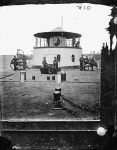
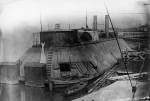
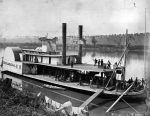
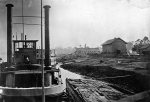




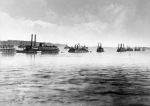
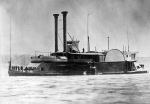
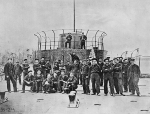



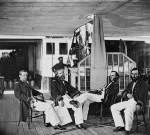

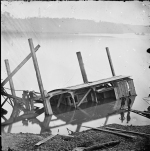


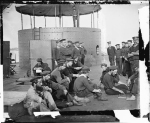

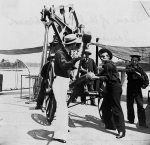
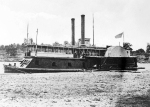



![The monitors USS Chimo and USS Tonawanda [Foreground] and the ex-CSS Stonewall [Background] moored off the Washington Navy Yard, Washington, D.C.](https://i.gr-assets.com/images/S/compressed.photo.goodreads.com/hostedimages/1501156346i/23422754.jpg)
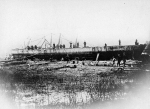


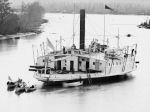

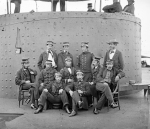
Controlling the Mississippi River and its tributaries was a vital part of the war effort. I can see why so much innovation happened in such a short amount of time. Technology provided an advantage, and in the narrow confines of a river, that advantage is beneficial for a brown water navy. With the tale crossing empires, expect to read about plenty of gunboats within the pages of Coal Belly.
The pictures above have been collected over the last five years, so I am unsure from where they all come (usually the Library of Congress.) But, they’re all old enough to be in the public domain. As before, in some cases, I did some minor color correction and cropping. I’m happy to answer any questions folks have about any of these images or riverboats in general. (Sometimes it gives me a good excuse to research something.) You can send me an email or leave a comment below. I love comments.
This is the latest in my series of posts sharing my findings from my research for Coal Belly. You can check out the other riverboat-related posts in the links below.
A Riverboat’s Roustabouts
A Riverboat’s Menu
Riverboat Interiors
Riverboats & Levees
The Masonic Ironclad
 Want to stay in touch with me? Sign up for Dead Drop, my rare and elusive newsletter. Subscribers get news, previews, and notices on my books before anyone else delivered directly to their inbox. I work hard to make sure it’s not spammy and full of interesting and relevant information. SIGN UP TODAY →
Want to stay in touch with me? Sign up for Dead Drop, my rare and elusive newsletter. Subscribers get news, previews, and notices on my books before anyone else delivered directly to their inbox. I work hard to make sure it’s not spammy and full of interesting and relevant information. SIGN UP TODAY →
Filed under: Coal Belly, Research Tagged: american civil war, battle of hampton roads, Coal Belly, cottonclad, ironclad, john ericsson, merrimack, mississippi river, monitor, navy, ram, riverboats, timberclad, tinclad








July 17, 2017
Cast the Bones
“People on the outside think there’s something magical about writing, that you go up in the attic at midnight and cast the bones and come down in the morning with a story, but it isn’t like that. You sit in back of the typewriter and you work, and that’s all there is to it.”
Filed under: Quotes Tagged: creative life, hard work, harlan ellison, inspiration, perseverance, writing








July 15, 2017
The Horror Brew Giveaway is Almost Over
The Horror Brew Giveaway ends in a little over 24 hours! Today is the last full day you can enter to win a signed copy of The Stars Were Right and a Bell Caravans patch. Entering is easy, and there are plenty of ways to increase your chances of winning. Click the link below, join in, and be sure to tell your friends.
Enter Today →
[image error]If you haven’t had a chance yet, be sure to check out to my interview with Matt and Cat from their Brews & Interviews series for Horror Brew. In it, we talk about The Bell Forging Cycle, discuss the weird-west, delve into the interconnectedness of Stephen King’s work, and a whole lot more. It was a lot of fun, check it out here. Be sure to subscribe, and leave a review!
Filed under: Contests Tagged: bell caravans patch, giveaway, horror brew, Interview, the stars were right








July 7, 2017
Six Hundred
This blog is a story in itself. It’s the documentation of a journey. Growing up, I remember my grandmother talking about becoming a novelist. She often spoke of the stories she wanted to share, the memoirs of her life, but she never finished her book. I believe the world is a little less without her words. From the beginning, the intent of I Make Stories was to chronicle my process of becoming a novelist—the good and the bad. As I have shared my experiences, I often wonder: what would have happened if my grandmother had read this blog as a fellow writer? Would she have been dissuaded or encouraged?
On that note, it’s time for a bit of reflection, and hopefully a bit of encouragement. It’s become a tradition around here that every two hundred posts I pause and take a moment and look back at what has happened in the time between. In 2014 I wrote my two-hundredth post, in 2015 I hit number four hundred, and here I am in 2017 looking at number six hundred. It’s been a long trail.
Things haven’t always been easy, but generally, nothing worth doing is easy. Days of discouragement are as common as the days of victory. Even as I write this post, I’ve been struggling through some serious self-doubt. I’ve come to expect it now, it’s a part of creation. Random events interrupt and derail process and progress. Writing takes time and effort, and it can often be a lonely endeavor. It requires a commitment to yourself and often that is more difficult than we realize.
“Milestones are meant to be passed.”
But even with the trials of creative work, things haven’t slowed during the last two hundred posts. Each obstacle has been surmounted and I’ve found successes along the way. I’ve sold a lot more books, many thousands now in total. I’ve hit the Amazon best-seller page multiple times. My presence at conventions has also expanded, and I’ve met some incredible people and new friends along the way.
On the story front, I launched Red Litten World which fans have enjoyed. I’ve finished the first draft of a standalone non-traditional fantasy (the title which I am keeping secret), and I’m nearly done with the first draft of Coal Belly my enormous steampunky riverboat adventure. Then it’s on to book four of the Bell Forging Cycle.
I’d like to think the content on this blog has gotten better as well. I’ve begun to share some of my discoveries in my research and delve into more details in the world of the Territories. There’s also this little thing which fans of the Bell Forging Cycle have yet to unravel. Plus, I have some other exciting plans for the future.
I couldn’t have done this alone. Although she never knew me as a writer, there is something of my grandmother in everything I write and for that I thank her. She might not have told her stories, but she empowered me to tell mine. And of course, there is you; my readers. I couldn’t be here, looking back from post six hundred, without you. Thanks for the passion. Thank you for buying my books. Thanks for reading them, and leaving reviews. Thank you for telling your friends and helping to spread the word. Thank you for the emails and the encouragement. There’s a lot of books out there to read, and I’m so grateful you picked mine.
As before, I won’t dwell here long. Stick with your work fellow creators. Milestones are meant to be passed. Number eight hundred lies somewhere in the distance and who knows what we’ll see in the spaces between.
Filed under: News, Writing Tagged: 600, blogging, Coal Belly, conventions, milestones, red litten world, reflections








July 5, 2017
I’m On Horror Brew
Last week I was lucky enough to join Matt and Cat from Horror Brew, one of my favorite horror-themed podcasts for Episode Thirteen! (Yeah, creepy thirteen! Kismet right?) I had a great time and was happy to be apart of the show. We talked about my books and the world of the Bell Forging Cycle. After that we delve into the weird west and then talked about horror in general; everything from Stephen King’s The Mist to Netflix’s Hemlock Grove. Give it a listen. I’ve embedded it below, so you can listen here or click one of the links and be sure to subscribe!
https://kmalexander.files.wordpress.com/2017/07/ep13_kmalex.mp3
iTunes • Stitcher • PlayerFM • Libsyn
You can follow Matt and Cat on Facebook, Twitter, Letterboxd, and Instagram. Make sure you subscribe and leave them a review. They put out a great show and are a passionate voice for the horror community. If you’re in the Portland area, check out their weekly horror trivia night at Home, A Bar. It’s a good crowd, and there are usually great prizes. Speaking of…
[image error]
From now until July 17th you can enter to win a signed copy of my first Lovecraftian urban fantasy novel, The Stars Were Right and a Bell Caravans patch. (I’ll probably throw in some other swag as well.) Entering is super easy, and there are ways you can win bonus entries to better your chances for success. All it takes is a few clicks, enter today and tell your friends!
Enter Today →
Filed under: News Tagged: bell caravans patch, bell forging cycle, giveaway, horror, horror brew, Interview, lovecraft, Podcast








June 20, 2017
Hunting The Yellow Sign
In 1895, Robert W. Chambers published The King in Yellow a collection of short stories. Over the years, it has become his seminal work, and due to Lovecraft’s interest in the book and his incorporations of Chamber’s ideas, The King in Yellow inevitably became connected to the mythos. Chamber’s eponymous King in Yellow, became Lovecraft’s Hastur, and the empty streets of dim Carcosa are now as familiar to cosmic horror fans as the sunken city of R’lyeh and the sagging gambrel roofs of Innsmouth.[1]
“Have you found the Yellow Sign?”
— Robert W. Chambers, The Yellow Sign, Chapter 14
For a long time, fans of Chambers’ work have hunted for The Yellow Sign. After all, it is important enough to justify a story within the book. But, unlike Lovecraft who was fond of random sketches, as far as we know Chambers never drew out the symbol. All we have are his descriptions. So what is the Yellow Sign? Did Chambers leave us any clues outside his story?
First, we need to address the Ross Sign. In 1989 Chaosium released The Call of Cthulhu 4th Edition, a role-playing game based on Lovecraft’s mythos. Within the supplemental book, The Great Old Ones, game designer Kevin A. Ross created a striking symbol of The Yellow Sign[2] for his adventure scenario entitled Tell Me, Have You Seen the Yellow Sign?
[image error] The Kevin A. Ross interpretation of The Yellow Sign
In the years since Ross’ symbol has become the go-to image whenever anyone evokes The Yellow Sign in popular media. A quick google image search will reveal a few variants, but most follow the same pattern. But, as engaging as it is, it’s important to note that the Ross Sign is not official. It’s not the mark described by Chambers, merely an interpretation by Ross adopted by the community at large. So what is The Yellow Sign? To find out, it’s best to return to the text where we find it described.
“…inside lay a clasp of black onyx, on which was inlaid a curious symbol or letter in gold. It was neither Arabic nor Chinese, nor, as I found afterwards, did it belong to any human script.”
— Robert W. Chambers, The Yellow Sign, Chapter 2
That quote taken from The Yellow Sign, (the fourth story in The King in Yellow), led me back to the original 1895 edition published by F. Tennyson Neely. They’re difficult to find physically, but most have been scanned are now available to read online. While the interiors were sparse, I found a few original covers of the first edition, which had a variety of printings featuring different covers.
[image error] The King in Yellow First Edition Covers, starting left First Printing to Third
The books above are ordered by the print run. You’ll note, that each cover bears a similar symbol with strange angles and sweeping curls. At fist glance, it certainly fits the description. It’s script like, and could easily be reminiscent of non-English glyphs. I did some work to pull the icon from the old covers so we could see it without all the filigree.
[image error] The Neely Sign from the first editions
I’m dubbing this the Neely Sign, and I was ready to accept it as the official version. And I wasn’t alone, I’ve seen it used by others. It’s clear that it’s in the zeitgeist just not as popular as the Ross Sign. It is similar to the description, looking not unlike Arabic letterforms or Chinese hànzì, but it’s clearly not born of either. I can see the appeal. My own rendering of Aklo follows similar patterns, loops, dashes, and dots. (You can see the writing here, just scroll down to book IV, V, and VI.) However, after some digging, I came across another cover; a cover that ruined any assumption of the Neely Sign being our infamous Yellow Sign.
[image error] Father Stafford by Anthony Hope, published by F. Tennyson Neely
Anthony Hope’s Father Stafford features the same mark, and it’s important to note that this book isn’t connected to the mythos. It has been described as a “county-house comedy” which is far different from the grim nature of The King in Yellow. So if that is The Yellow Sign on the cover it would be wildly out of place. So what is it? The connection lies with the publisher. Both Father Stafford and The King in Yellow were published by F. Tennyson Neely under the Neely’s Prismatic Library imprint. You can easily see the letters F, T, and N in the symbol, and the periods clearly indicate initials. Further research found the symbol on other covers as well, including this copy of Master and Man by Tolstoy. So, it seems the Neely Sign was the publisher’s mark and not the official Yellow Sign as many have hoped. So I was back to square one… or was I?
“We talked on, unmindful of the gathering shadows, and she was begging me to throw away the clasp of black onyx quaintly inlaid with what we now knew to be the Yellow Sign.”
— Robert W. Chambers, The Yellow Sign, Chapter 18
I eventually found an old post from 2010 on of my favorite blogs, Propnomicon. It’s a fantastic site focused on documenting the creation of realistic props that evoke Lovecraftian mythos (and horror in general.) Within the post, they suggest that the image on the spine of third first-edition printing (and arguably the most memorable) might be The Yellow Sign. It begged a closer look.
[image error] The King in Yellow by Robert W. Chambers, First Edition, Third Printing published by F. Tennyson Neely
It’s a remarkable symbol. You can see a similar object held by the figure. A torch consuming itself, or a burning scepter perhaps? When isolated it looks a bit like a caduceus turned upside down. Could this inverted caduceus, a symbol typically used to represent healing, be a representation of corruption? I think there is merit in that interpretation. After all, Hastur clads himself in yellow, which is opposite on the color wheel of purple, the standard color of royalty. Even Carcosa itself is often shown as a corrupted reflection of our world. Plus when stylized, the inverted torch looks like something you could see embroidered on the stoles and hoods of a Yellow King secret society. It has a symmetry, not unlike the Rebekah’s beehive or the Masonic square and compasses and that is advantageous in a symbol’s use. Effective symbols are easy to reproduce, and while the Ross and Neely signs are interesting, they’re overly complex.
[image error] Symbol from the spine of Chambers’ The King in Yellow
By this point, I think it will be difficult to uncouple popular culture from the Ross Sign. But, personally, I’ve become a fan of the inverted torch and I will probably go forward using it to represent Hastur within my own work. I like that it has more connection with the original text than the Ross creation and it’s not a misinterpretation like the Neely Sign. Even if it doesn’t fully match the description it’s visually evocative.
While there have been other less grounded interpretations[3], there is no one definite answer. Chambers, for his part, was vague; I’d wager that was intentional. He left the titular Sign open to discussion and that is why it remains undiscovered. For me, that adds to the myth and it helps expand the world of cosmic horror. The mystery becomes a part of the draw and that is something I can appreciate.
Then again, there’s also this strange little mark…
1 It should be noted that Ambrose Bierce was the first to name both Hastur and Carcosa. They appeared in his short stories Haïta the Shepherd, and An Inhabitant of Carcosa found in his 1893 collection Can Such Things Be? Both stories were drawn upon by Chambers for The King in Yellow.
2 It’s important to note that the Ross Sign that we see today is actually a corruption of Ross’ initial design. Chaosium printed the image both upside-down and backward.
Filed under: Research Tagged: anthony hope, carcosa, cosmic horror, f. tennyson neely, father stafford, h.p. lovecraft, hastur, kevin a. ross, propnomicon, robert w. chambers, symbol, symbolism, the king in yellow, the yellow sign, tolstoy, yellow king 







June 7, 2017
A 2017 Lilac City Comicon Debriefing
It’s time for a con debriefing! Last weekend, I spent a couple of wonderful days at Lilac City Comicon in Spokane, Washington. This was my third year at LCCC, and like previous years, I shared a table with my good friend Josh Montreuil. This time around the con not only expanded, but it’s now two wonderful days.
[image error] [Left] My table setup [Right] One of my readers sporting an awesome Negan cosplay!
Last year, I sold out of every copy of The Stars Were Right, so I doubled down and brought more with me this time around. Well, Spokane was insatiable, once again I sold out of every copy of The Stars Were Right. Yep, all gone! It was incredible. Easily one of the best two-day stretches I’ve had while running a table at a convention which means a whole lot of new readers have begun to experience The Bell Forging Cycle.
[image error] [Left] Josh speaks with a T-Rex, his target audience [Center] The Log Lady! [Right] A pair of ninja 4 hire
Time for the highlights:
Friday night’s LCCC Pro Drink & Draw was great. Met some good people and I was able to circle up with some friends. It was a relaxing way to go into a busy weekend.
Once again (as the pictures prove) Spokane really went all out with the cosplay. Amazing work by everyone participating, you could see the time people had dedicated to their costumes. I took a ton of photos, and it was tough narrowing it down and picking favorites to share. Great work everyone! (Sgt. Slaughter, see below, was a particular favorite, but that’s the Joe fan in me coming out.)
My mom, dad, sister, and my nephew Derek came out to say hello! It Derek’s first convention and it was amazing to see the excitement as he strolled around in his Pikachu costume. He also left with the desire to be a Roader, which I appreciated. Gotta start ’em young. Right?
Likewise, Kari-Lise’s cousin Lou and his son Damon also came out. It was great seeing them as well. It’s nice to have a supportive family in the area. (You can check out a pic of Damon below dressed as a ninja.)
It was good to hang out with Josh. He had a new comic this year, Triceratots , and a load of prints. People were really excited to meet him and check out his work. Especially giant monster fans. I highly recommend you follow him. He’s got big plans for the coming year. If you want to meet him, I know he’ll be at Coeur d’ Con in Coeur d’ Alene, Idaho in August. If you live nearby check his stuff out.
The volunteers were fantastic. It needs to be said over and over. Big thank you to them and to Nathan O’Brien for working so hard to make the convention so successful.
Several times I had readers drop by and ask about the status of book four. Knowing there is excitement building gets me excited. I really appreciate knowing there are those eager to join Wal in another adventure. I’ve heard it’s going to be a doozy. After all, “ He is coming. Can’t you smell it on the wind? “
Once again it was good to spend time with Matt Nelson , Peter Foglesong , Jennifer Foglesong , and Lars Brown . All our tables were next to each other, and it was great being able to hang out and chat during the downtimes. If there is such a thing as your ‘convention family’ they’re definitely a part of mine.
[image error] [Left] Captain America [Center] My nephew Derek as Pikachu and me as an author who only wears black [Right] Geralt of Rivia
I also had several readers come up just to meet me and tell me how much they loved my books. It was amazing and surreal, and it’s interactions like that which really made my LCCC experience. Writing is a solitary gig, and when people take the time to come up and say they appreciate the hard work, it makes it all worthwhile.
Since the con was two days, the Post-Con Decompression Dinner became a Mid-Con Decompression Dinner. It was still as great as always. The food and drink hit the spot, the conversation was lively, and it was a pleasant respite in the middle of the festivities.
Josh’s sketch commissions were as wacky and wonderful as always, from Daffy Duck as The Scarlet Pumpernickel to a giant antlered bear armed with a great ax.
I enjoyed seeing all my old friends who came by to say hello, Angie, Curt, Carl, and Mike (who surprised me from behind his King Kong mask.) It was nice seeing them, meeting their partners and children, and catching up a little bit.
I got to nerd it up with a bunch of horror fans. We talked about Lovecraft, Chambers, The Void, Get Out, The Mist, and so much more.
I met some new friends as well. In particular, Rob an illustrator who creates some great Lovecraftian illustrations, Devin who was hanging out across from Josh and me, and Michael another illustrator who ran a table next to ours.
Did I mention I sold out of EVERY COPY of The Stars Were Right? EVERY. COPY. Seriously. I did. (I have more on order.) It’s awesome to see so many people starting their journey into the world of The Bell Forging Cycle . If you’re one of them, I hope you enjoy the ride.
When I got home late Sunday night I was greeted by the nicest email from a reader who had picked up my books and took a moment to drop me a line to tell me she was already loving them. After a long afternoon of travel, it absolutely made my night.
[image error] [Left] Sgt. Slaughter [Center] Rebel Pilot [Right] Kari-Lise’s second cousin Damon as a nunchaku spinnin’ ninja
The expansion from one to two days was excellent, and other pros enjoyed it as well. Clearly, Spokane is hungry for a world-class convention, and Lilac City is stepping up and providing. I’ll most certainly be attending in 2018. I would love to see LCCC expand into open gaming and more panel tracks as well, but I am sure both are coming. Make sure to follow them on Instagram and Twitter.
Want to read about my past experiences? Check out my debriefings for Lilac City Comicon 2016 and Lilac City Comicon 2015. Next up for me in 2017 is OryCon in November! Remember, You can keep track of where I’ll be and check out my previous conventions over on my Upcoming Appearances page.
Thanks for a great con Spokane, I’ll see you next year. 
May 31, 2017
Come See Me at Lilac City Comicon 2017
This weekend I will be returning for the 2017 celebration of Lilac City Comicon in Spokane, Washington. This year the convention is two whole days running from Saturday, June 3rd to Sunday, June 4th. If it’s anything like the last few conventions, it’ll be a blast. I’ll once again be sharing a table with comic creator and dinosaur enthusiast Josh Montreuil and we’re both bringing a ton of great stuff.
[image error] Triceratots, by Josh Montreuil – debuting at LCCC 2017!
I’ll have copies of The Stars Were Right, Old Broken Road, and Red Litten World. I’ll also have Bell Caravans patches as well as a ton of free swag, stickers, bookmarks, and buttons. In the past, LCCC hasn’t really been interested in my badge ribbons, but I’ll have mine with me, and like other swag they’re free. If you want to draw a ribbon from THE BOX OF CHOOSING™ just ask me and I’ll be happy to let you try your luck. (Full details on the badge ribbons can be read here.)
Sir Montreuil will have his new debut comic, Triceratots, available! I’ve been given a preview, and it’s not only incredibly fun, but it’s downright adorable. If you’re a fan of dinosaurs or know someone who is (I mean, who isn’t?), be sure to pick it up. He’ll also have a bunch of fresh prints and will be available for sketch commissions.
You can find Josh and me at TABLE C10 right in the center of it all. Click the image below to see where you can find us on the full map. It’s like a treasure map, but you’ll be crossing booths filled with cool stuff and not boring desert islands.
I’m looking forward to the weekend, there are a ton talented people participating, and the 1966 Batmobile will be there! Check out the full guest list and complete exhibitor list over at the official Lilac City Comicon site. I’ll see you there!
 Want to stay in touch with me? Sign up for Dead Drop, my rare and elusive newsletter. Subscribers get news, previews, and notices on my books before anyone else delivered directly to their inbox. I work hard to make sure it’s not spammy and full of interesting and relevant information. SIGN UP TODAY →
Want to stay in touch with me? Sign up for Dead Drop, my rare and elusive newsletter. Subscribers get news, previews, and notices on my books before anyone else delivered directly to their inbox. I work hard to make sure it’s not spammy and full of interesting and relevant information. SIGN UP TODAY →
Filed under: Upcoming Appearances Tagged: bell caravans patch, josh montreuil, lilac city comicon, old broken road, red litten world, ribbons, spokane, swag, the stars were right, triceratots











